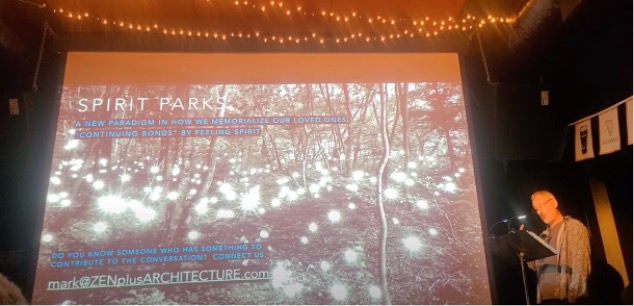by Mark Miller
It’s a milestone day for me. After a six-year journey in developing a smartphone app as a side hustle from my day jobas a passive house architect, I am thrilled to share my Love Notes app is now live on The App Store. High five me, my brothers! Love Notes is an app that captures love; it grows “continuing bonds” with the most importantrelationships in your life by creating a digital time capsule in the cloud for them to tap into whenever they need a hug.This is one of the manifestations of my men’s work’s spiritual mission: to create a world full of loving and caring, by designing meaningful experiences to create loving and caring in others and myself.
To give you context, we have to go back to the year 1999, when my wife and I started our family. My daughter Zoë was born in November. I was 36 years old, the same age my own father was when he died of a sudden heart attack.I was only two at the time. My sister was 1 month away from being born, which would leave my mother having tomarch forward to raise 3 children on her own. I would learn later as an adult, it also left her with severe depression for the rest of her life, from not being able to properly grieve when my father passed. As you can imagine, I was sweating bullets this first year of my daughter’s life, worrying, “what if I too followed my father’s fate?”.
This forced me to face the reality that should I transition to the other side, how can I keep loving and supporting my precious baby throughout her life? I was so excited to be a “Dad” because I didn’t know what a father/child relationship was like, growing up without my father. This time around I would learn what that relationship was like,albeit from the other side of that relationship, which I was really looking forward to, to fill in these missing pieces in my life.
This led me to think about where it is in our culture that the living come to connect with those on the other side. The answer, of course, is a cemetery. I don’t know about you, but most people I speak with rarely, if ever, go to visit their loved ones in a cemetery. Many are “creeped out” by these fenced-off environments, usually on the outskirts of town. It’s fair to say our culture hides death, thus leaving most Americans with a very poor relationship with it. As an architect who designs environments, I have to agree that most places I’ve visited are not designed well to do a good job of being a sacred place for supporting this connection between the living and the dead. In fact, there usually aren’t any benches, which would signal “come, stay as long as you would like, and connect with your loved one”.
I believe love is a verb. One can’t “verb” in most cemeteries. Sure, you can bring some cut flowers, but there aren’t opportunities in the design of most cemeteries to allow us to show acts of love to our ancestors and loved ones.People are looking for ways to be participants, not just observers. I had the good fortune to visit Japan last summer.The cemeteries in Japan have kiosks of incense and candles for you to place on your loved one’s gravestone when visiting. They also have gardeners’ watering cans and planting materials for you to use, to enhance the area around your loved ones. I was most impressed with their Obon Festival, similar to Mexico’s Day of the Dead, where the spirits of our ancestors come down from the mountains for the weekend. People write a love letter to them, which is placed in a paper lantern, set in the river, which helps guide the spirits back home to the mountain. Many opportunities to participate in the ritual of connecting with the spirits of loved ones.
As an architect, it feels like most of our western cemeteries got stuck in the painful “grief” side of the process of losing a loved one, and forgot to continue forward to the celebration of their life, and the staying-connected-often side of the process. This has inspired the architect in me to re-imagine the cemetery, to make it work better for people in today’s society to have a healthier relationship with death. To create a sacred place for processing grief, healing, reflecting, and most importantly, a place that feels good to come to, to connect with our loved ones whohave
passed and get nourished by hearts connecting with our ancestors. I would want my daughter to feel as if she was getting a big hug from dad, when she came to visit. I call this new form a Spirit Park. You can learn about it here:
www.lovenotes.club/spirt-parks
So I was sharing my idea with my cousin one day, and he says, “Mark, I love the idea, but that’s like a 10 year projectto manifest such a place and a lot of capital would be needed. Is there some other idea, where you can get the same mission out there sooner?”.
Serendipitously, it turned out I signed up for the Path 2 Spirit men’s retreat that month. Having the opportunity to unplug from daily life and really focus on my connection to spirit brought about the clarity that I could design an appthat would help people create and strengthen their “continuing bonds”. What I have come to realize is that it is lovethat keeps hearts connected from the living to the dead, over generations. And “now there’s an app for that”.
Well, six years later, now there’s an app for that. So, how do you capture love? My solution was to allow parents to create “Love Notes” in the form of a text document, an audio file, a photograph or a video. These would be archives of the most meaningful moments between a parent and a child, to build up a time capsule of love that lives in thecloud. Always available to love and support your child when needed, they could revisit these treasures now, and even after one transitions to the other side. The real magic of the app is that you are encouraged to leave “commentary” for each love note, telling your child(ren) how this particular item or moment makes you feel about them. One of themost foundational truths about children is that they yearn to hear words of praise, appreciation, and gratitude from their parents, and the Love Notes format is a great place to capture that “love”.
It’s turning out that single parents seem to jump up first and loudest when I explain what the app does. They too, like me, worry that they might perish before their golden years, and they understand how the app can help them be prepared, should this become a reality for their family. Other folks that resonate with the app are parents in high-riskoccupations, think police, fire, and military personnel. It’s also helpful to those with a terminal illness, with limited timeleft,
it’s a tool to help them archive their love for those they are leaving behind, in preparation to “stay connected”. Share your love, bare your soul, while you can.
I’m happy to see how my brothers in the men’s work community (Men Living, ManKind Project, Path 2 Spirit Warrior,etc.) I’ve shared my story with, and immediately recognize the importance and value of parents taking the time to archive their love and grow their continuing bonds. I’m hoping you will download the app from the Apple Store (android version coming in a few weeks); try making a few love notes to share with those most important relationships in your life. If you like the app please help me by being an ambassador and simply tell others about the app if it could be helpful to them, like it is being helpful to me. I’m sure many share my feelings.
Thank you for your support, bothers. Now on to getting one of these Spirit Parks manifested.
https://apps.apple.com/us/app/love-notes-time-capsule/id1550560517
Meet Mark Miller
mark@lovenotes.club
Pioneering green architect; engaged husband and father of two Waldorf educated young adults; life long student of internal arts including Shotokan Karate and Aikdio (the way of harmonizing energies), yoga and meditation.Trombonist and Sousaphone player in the band Eve’s Undoing. Sport motorcycle tourer. Men’s work path since 2011 and happy to grab a coffee with brothers visiting the Evanston area.
Biography
Mark’s spiritual journey started when studying Japanese martial arts in college. Studying “moving meditation” during his schooling as a green architect has set him on a path of combining these two passions, designing environments that connect its users to the rejuvenating forces found in nature, sunlight and the invisible energy of life (ki) that surrounds all. He now is one of a few architects who can design “Net-Zero Passive Houses” the world’s most energyefficient, resilient, comfortable, healthy air quality, fire-resistant and eco-friendly all electric houses powered by the suns clean renewable energy, providing the building sector’s response to climate change.




